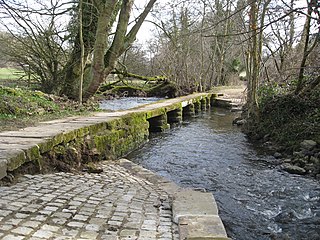Butterley Reservoir may refer to:
- Butterley Reservoir, Derbyshire, England
- Butterley Reservoir, West Yorkshire, England
Butterley Reservoir may refer to:

Ripley is a town in the Amber Valley borough of Derbyshire, England.

William Jessop was an English civil engineer, best known for his work on canals, harbours and early railways in the late 18th and early 19th centuries.

The Cromford Canal ran 14.5 miles from Cromford to the Erewash Canal in Derbyshire, England with a branch to Pinxton. Built by William Jessop with the assistance of Benjamin Outram, its alignment included four tunnels and 14 locks.

The Midland Railway – Butterley is a heritage railway at Butterley, near Ripley in Derbyshire.

The River Amber is a left bank tributary of the River Derwent in Derbyshire, England. It gives its name to the local government district and borough of Amber Valley.

Ironville in Derbyshire, England, was built about 1830 by the Butterley Company as a model village to house its workers. The population of the civil parish was 1,930 at the 2021 Census. It is situated between Riddings and Codnor Park.

Yorkshire Water is a water supply and treatment utility company servicing West Yorkshire, South Yorkshire, the East Riding of Yorkshire, part of North Lincolnshire, most of North Yorkshire and part of Derbyshire, in England. The company has its origins in the Yorkshire Water Authority, one of ten regional water authorities created by the Water Act 1973, and privatised under the terms of the Water Act 1989, when Yorkshire Water plc, the parent company of the Yorkshire Water business, was floated on the London Stock Exchange. The parent company was Kelda Group in 1999. In February 2008, Kelda Group was bought by a consortium of infrastructure funds.

The Butterley Company was an English manufacturing firm founded as Benjamin Outram and Company in 1790. Its subsidiaries existed until 2009.

Butterley Tunnel is a 3,083-yard (2,819 m) disused canal tunnel on the Cromford Canal below Ripley, in Derbyshire, England, opened to traffic in 1794. Along with Butterley Works blast furnaces, part of the canal tunnel and its underground wharf were declared a scheduled monument in 2013.

The Wessenden Valley is a moorland valley in the Dark Peak, immediately south of Marsden in West Yorkshire, England. The name Wessenden derives from Old English and means the 'valley with rock suitable for whetstones'. The valley was formed by retreating glaciers at the end of the last ice age and continues to be cut by the Wessenden Brook a tributary of the River Colne with a catchment of 6.28 square miles (16.27 km2).
Butterly is the name of:
Nigel Henry Cockburn Butterley was an Australian composer and pianist.

Butterley railway station is a preserved railway station on the Heritage Midland Railway - Butterley in Derbyshire.

Butterley Reservoir is a reservoir in Derbyshire, England. The reservoir was built to provide water for the Cromford Canal which opened for use in 1794. The Codnor Park and Butterley Park reservoirs also provided water to the Cromford Canal.

Hammersmith railway station is a heritage railway station on the Midland Railway – Butterley in Derbyshire.

The Ambergate–Pye Bridge line is a partially opened and closed railway line in Derbyshire, England. It was a short east–west line linking the Midland Main Line with the Erewash Valley line. The line was opened by the Midland Railway to freight on 1 February 1875, and to passenger trains on 1 May 1875. The Midland was grouped into the London, Midland and Scottish Railway (LMS) in 1923.
David Anthony Ahern was an Australian composer and music critic, who became a prominent artist in the avant-garde genre after his best-known work, Ned Kelly Music was released and performed at the Sydney Proms music series.
Fritchley Tunnel is a disused railway tunnel at Fritchley in Derbyshire, England, which is believed to be the oldest surviving example in the world. The tunnel was constructed in 1793 by Benjamin Outram as part of the Butterley Gangroad, altered in the 1840s, and remained in use until the railway closed in 1933. It is a scheduled monument.

The Yorkshire Water Way is a 104-mile (167 km) path that runs from Kettlewell in North Yorkshire to Langsett in South Yorkshire. It was devised by Mark Reid in conjunction with Yorkshire Water (YW) and it passes by over more than 20 reservoirs which are operated by Yorkshire Water.

Butterley Reservoir is a reservoir located near Marsden, West Yorkshire, near the Peak District National Park boundary. It was completed in 1906. The reservoir is known for its long stepped spillway, which is grade II listed.